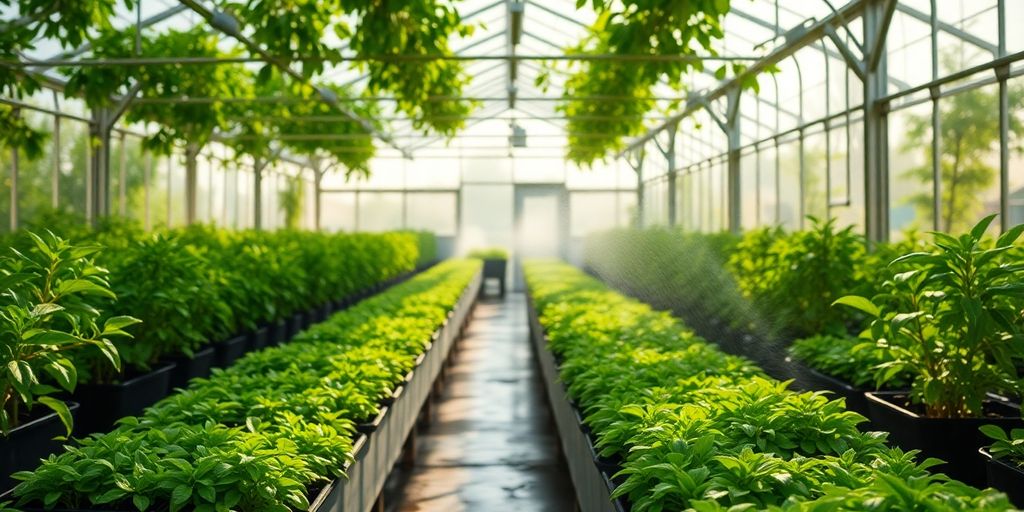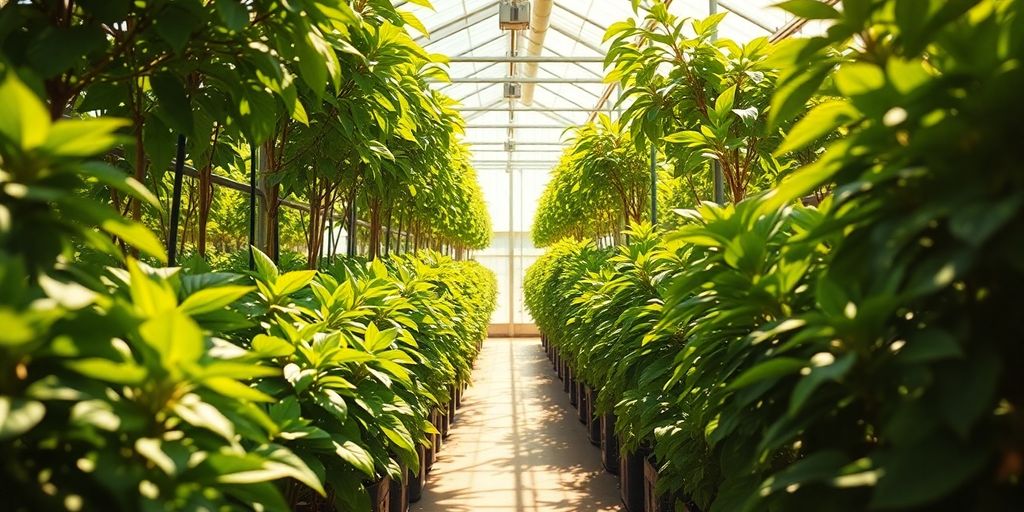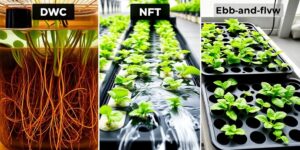Keeping your plants happy and healthy in a greenhouse means getting the temperature just right. It’s not always easy, especially when the weather outside can’t make up its mind. You’ve got to think about heating when it’s cold and cooling when it’s hot, and how to make it all work together. This guide is all about figuring out the best ways to handle greenhouse heating and cooling so your plants can grow their best, no matter what season it is. We’ll cover the basics and some more advanced tips to help you out.
Key Takeaways
- Stable temperatures are really important for plants to grow well, affecting everything from how they use energy to how their roots develop.
- Using radiant heating can give you even warmth, while built-in systems are good for keeping things toasty in winter.
- Evaporative cooling and good ventilation help keep things from getting too hot, and shade cloths can block out too much sun.
- Balancing your heating and cooling is key, and using things like water barrels can help keep temperatures steady naturally.
- Keeping an eye on the temperature and humidity with sensors and automated systems makes it easier to adjust things before problems start.
Understanding Greenhouse Temperature Dynamics
Keeping your greenhouse at the right temperature is a big deal for your plants. It’s not just about making it warm or cool; it’s about keeping things steady. Plants are pretty sensitive to temperature changes, and even small shifts can mess with how they grow and develop. Think of it like this: if you were constantly being moved between a sauna and an ice bath, you wouldn’t be too happy or productive, right? Plants are similar.
The Crucial Role of Stable Temperatures
Stable temperatures are the bedrock of a healthy greenhouse environment. When the temperature stays within a plant’s preferred range, everything just works better. Germination rates improve, photosynthesis runs smoothly, and roots develop properly. Fluctuations, on the other hand, can stress plants, making them more susceptible to diseases and pests. It’s all about consistency to avoid shocking your plants.
Impact of Temperature on Plant Physiology
Temperature directly influences a plant’s internal processes. For instance, seed germination has a sweet spot for temperature; too cold or too hot, and those seeds just won’t sprout. Photosynthesis, the plant’s way of making food from light, also has an ideal temperature range. If it gets too cool, photosynthesis slows down. If it gets too hot, it can shut down altogether. Even root development is affected by soil temperature, impacting how well plants can take up water and nutrients. Different plants have different needs, so knowing your specific crop’s temperature requirements is key. For example, tomato seeds do best when germinating between 70 and 80°F, while many common garden plants prefer temperatures between 68 and 77°F for efficient photosynthesis. Understanding these physiological responses helps you manage your greenhouse climate more effectively.
Seasonal Challenges in Climate Control
Greenhouses are great because they let you control the environment, but they don’t magically solve all weather problems. During the spring and fall, you can get wild temperature swings. One day it’s warm enough to open everything up, and the next, you’re worried about frost. Summers can bring intense heat that quickly overheats a closed-up structure, while winters demand consistent heating to prevent freezing. A new greenhouse can reach temperatures over 18°C during the day, creating a temperature difference of 6°C between its interior and exterior, showing how quickly conditions can change. You have to be ready to adjust your heating and cooling strategies based on what’s happening outside. It’s a constant balancing act to keep those internal conditions just right, no matter what the season throws at you. This means paying attention to forecasts and being prepared to make changes to your greenhouse heating system.
Managing temperature isn’t just about hitting a target number; it’s about creating a predictable and supportive environment that allows plants to do what they do best: grow.
Essential Heating Strategies for Year-Round Growth

Keeping your greenhouse warm enough for plants to thrive all year round is a big deal, especially when the weather outside decides to get nasty. You can’t just rely on the sun; sometimes, you need a bit more oomph to keep things cozy.
Radiant Heating for Even Warmth Distribution
Radiant heating is pretty neat because it warms things up directly, like the plants and the soil, instead of just heating the air. This means you get a really even temperature throughout the greenhouse, with fewer of those annoying cold spots. It’s like standing in a sunny spot on a cool day – you feel the warmth right away. This method is great for making sure all your plants get the consistent heat they need to grow strong, no matter where they are in the greenhouse. It’s often more efficient than blowing hot air around, which can sometimes dry things out too much.
Built-In Heating Solutions for Cold Months
When winter really bites, you need heating systems that are designed to handle the job. Think about systems that are permanently installed, like those that run on gas or electricity, or even more advanced options like geothermal. These are the workhorses that keep your greenhouse at the right temperature when it’s freezing outside. They’re usually more powerful and reliable than portable heaters, which are more for a quick boost. Having a solid, built-in system means you don’t have to worry as much about sudden temperature drops ruining your crops. It’s about having that steady warmth that plants need to keep growing, even in the dead of winter. For a reliable setup, consider looking into direct vent gas heaters which are efficient and don’t need a chimney.
Selecting the Right Heating System
Choosing the right heater isn’t a one-size-fits-all thing. You’ve got to think about how big your greenhouse is, what you’re growing, and how cold it actually gets where you live. Electric heaters are good for smaller spaces, but they can get pricey to run. Gas heaters are often more powerful and cost-effective for larger areas. Then there are eco-friendly options like geothermal, which are great for the long run. It’s also smart to think about efficiency – you don’t want to waste a ton of energy just to keep things warm. Making the right choice now can save you a lot of headaches and money down the road. Plus, you want something that’s safe and easy to manage, so you can focus on your plants, not on fiddling with the heater all the time.
Effective Cooling Techniques for Optimal Conditions

Evaporative Cooling Methods Explained
When things get too hot inside, especially during those sunny summer days, you’ve got a few tricks up your sleeve. Evaporative cooling is a big one. It works by using water to cool the air. Think of it like how you feel cooler when you’re a little sweaty – the water evaporating off your skin takes heat with it. In a greenhouse, this can be done with misting systems or by wetting down pads that air is blown through. It’s a pretty natural way to bring down the temperature, and it can make a real difference, sometimes dropping the heat by 10–15 degrees Celsius below what it is outside. This is especially helpful if you’re growing plants that don’t like it too warm. It also adds a bit of humidity, which some plants appreciate. You can get systems that do this automatically, so you don’t have to constantly fiddle with it. For effective and efficient evaporative cooling, the Evaporative Cooler with 2800 CFM capacity is a solid option.
The Importance of Proper Ventilation
Ventilation is your greenhouse’s lungs. It’s not just about cooling, though that’s a huge part of it. Moving air around helps get rid of that hot, humid air that builds up. You can achieve this with roof vents, side vents, and exhaust fans. Good airflow does a few things: it cools the place down, brings in fresh air for the plants to use for photosynthesis, and helps stop diseases and pests from getting too comfortable. Without enough air moving, you can end up with stagnant pockets of heat and moisture, which is a recipe for trouble. Making sure your greenhouse has a good ventilation setup from the start is really key to keeping things healthy.
Utilizing Shade Cloths for Heat Management
Shade cloths are like sunglasses for your greenhouse. They block out some of the sun’s intense rays, preventing the inside from getting too toasty. You can get them in different densities, so you can choose how much sun you want to block. If it’s super hot and sunny, you might use a denser cloth. If it’s just a bit warm, a lighter one might do. They’re pretty straightforward to put up and take down, often just draped over the structure. Using them means less direct sun hitting your plants, which can prevent scorching and reduce the overall heat load inside the greenhouse. It’s a simple but effective way to manage the temperature when the sun is really beating down.
Balancing Heating and Cooling for Plant Health
Getting the temperature just right in your greenhouse is a bit like walking a tightrope. You need it warm enough for growth, but not so hot that your plants start to wilt. It’s all about finding that sweet spot where they can really do their thing.
Achieving Equilibrium in Greenhouse Climate
The goal here is to keep things steady. Wild temperature swings are tough on plants. They can mess with photosynthesis, slow down growth, and even make them more susceptible to diseases. Think of it like this: you wouldn’t want to be constantly jumping between a sauna and an ice bath, right? Plants feel the same way. We’re aiming for a consistent environment that supports their natural processes without causing stress.
Using Thermal Mass for Temperature Stabilization
One neat trick for smoothing out those temperature bumps is using thermal mass. This just means using materials that can soak up heat during the day and then slowly release it when things start to cool down at night. Things like water barrels, concrete floors, or even stone walls can do the job. They act like a big, slow-release battery for heat, helping to keep the greenhouse temperature more even. It’s a pretty passive way to help manage the climate, and it can cut down on how much you need to actively heat or cool.
Here’s a quick look at how different thermal mass materials can help:
- Water Barrels: Absorb heat during the day, release it slowly at night. Painting them black helps them absorb more heat.
- Concrete/Stone Floors: Store heat from sunlight, radiating it back into the greenhouse after the sun goes down.
- Brick or Stone Walls: Similar to floors, these materials can absorb and release heat, moderating temperature swings.
Adapting Climate Control to Plant Needs
Not all plants are created equal when it comes to temperature. Some tropical plants might love it toasty, while others, like certain leafy greens, prefer it a bit cooler. You really need to know what your specific plants are asking for. This means paying attention to their growth stages too; seedlings often need different conditions than mature plants ready to fruit. So, it’s not just about one set temperature for the whole greenhouse. You might need to adjust your heating and cooling based on what’s growing and where it is in its life cycle. It’s a bit of a juggling act, but getting it right makes a huge difference in how well your plants do.
Monitoring and Automation in Climate Management
Keeping tabs on your greenhouse environment is a big deal. It’s not just about setting a thermostat and forgetting it. You really need to know what’s going on inside to keep your plants happy.
Continuous Temperature and Humidity Monitoring
Think of sensors as your greenhouse’s eyes and ears. They constantly check the temperature and humidity, giving you real-time info. This data is super important because plants don’t like big swings in their living conditions.
- Placement matters: Don’t just stick a sensor anywhere. Keep it away from direct sun, vents, or heaters that could throw off the readings. Multiple sensors spread out give a better overall picture.
- Calibration is key: Make sure your sensors are accurate. Check them against a reliable thermometer now and then.
- Record keeping: Keeping a log of the readings helps you spot patterns over time.
Integrating Automated Climate Control Systems
This is where things get really interesting. Automation takes the guesswork out of managing your greenhouse. You can set specific temperature and humidity ranges, and the system will automatically turn on fans, heaters, or misters to keep things in check. It’s like having a dedicated greenhouse manager working 24/7. Many modern greenhouse automation systems can even coordinate ventilation and cooling for peak efficiency. This technology can help boost crop yields significantly by providing precise control over the growing environment. You can find out more about how these systems work to optimize crop production.
Leveraging Data for Proactive Adjustments
Once you’re collecting all this data, what do you do with it? You use it to get ahead of problems. If you see the temperature creeping up consistently, you can adjust your cooling system before it becomes a real issue. Or, if humidity is too high, you might need to increase ventilation.
Making small, informed adjustments based on the data you collect can prevent major problems down the line. It’s all about being proactive rather than reactive with your greenhouse climate.
By paying attention to what your sensors are telling you and letting automation handle the day-to-day adjustments, you create a much more stable and predictable environment for your plants. This consistency is what really helps them grow their best. It’s a smart way to manage your greenhouse and get better results from your plants.
Seasonal Adjustments for Transitional Climates
Transitional seasons like spring and fall can be a real wild card for greenhouse growers. One day it’s warm enough to open everything up, and the next, you’re worried about frost. It’s all about being ready for those temperature swings.
Managing Spring and Fall Temperature Fluctuations
Dealing with unpredictable weather means you need a flexible approach. Think about using thermal curtains – you can pull them shut at night to keep the warmth in and open them up during the day to let some heat escape. Also, keeping an eye on the weather forecast is a good idea so you can adjust your heating or cooling as needed. Sealing up any drafts is super important too, because cold air sneaking in can really mess with your plants.
The Role of Double-Layered Glazing
If you’re looking to invest a bit more, double-layered or twin-wall polycarbonate glazing can make a big difference. It’s like giving your greenhouse a cozy blanket. This type of glazing offers better insulation, which helps keep the temperature inside more steady, especially when the weather outside is doing its own thing during those in-between seasons.
Strategic Seasonal Plant Selection
It also helps to think about what you’re growing. Planting crops that can handle cooler weather in the spring and fall means you won’t have to work as hard to keep things warm. Then, you can save your heat-loving plants for the summer. It’s a simple way to reduce the stress on your heating and cooling systems and make sure your plants are happy with the conditions they’re getting.
Troubleshooting Common Greenhouse Heating and Cooling Issues
Even with the best setup, you might run into snags with keeping your greenhouse temperature and humidity just right. Catching and fixing these problems fast is key to happy plants. It’s all about figuring out why something’s off and then making sure it doesn’t happen again.
Addressing Temperature Stress in Plants
Sudden temperature swings can really mess with your plants, slowing down their growth. To fight this, make sure your greenhouse is well-insulated. Think about having a backup heater or cooler ready for those wild weather days. Stuff like bubble wrap or thermal screens can help keep a steady temp by stopping heat from escaping and blocking chilly drafts. Having a second heater or cooling unit means your plants are safe if the temperature drops or spikes unexpectedly.
Preventing Overheating and Dehydration
When it gets too hot, plants can wilt and stop growing. This is where cooling systems come in. Evaporative cooling, like misting or using shade cloths, can really bring down the temperature. Misting adds moisture, which cools things as it evaporates – great for dry places. Shade cloths block some sun, stopping the greenhouse from turning into an oven. You can get cloths with different densities to control how much sun gets in.
Resolving Cold Spots and Drafts
Cold spots and drafts are bad news. They can happen if your heating isn’t spread out evenly or if there are gaps in your greenhouse structure. Radiant heating systems are pretty good at spreading warmth evenly, which helps avoid these chilly areas. Make sure all your vents and doors seal up tight. Sometimes, just adding a bit more insulation to problem areas can make a big difference. Checking for and sealing up any cracks or gaps where cold air might sneak in is also a good idea.
Keeping an eye on your greenhouse climate is an ongoing job. Small issues, if ignored, can quickly become big problems for your plants. Regular checks and quick fixes are your best bet for a healthy growing space.
Wrapping Up Your Greenhouse Climate Control
So, we’ve talked a lot about keeping your greenhouse just right for your plants, whether it’s heating things up or cooling them down. It’s not always easy, especially when the weather outside can’t make up its mind. But by using things like radiant heaters when it’s cold, or evaporative coolers when it’s hot, and even using materials that hold heat, you can make a big difference. Paying attention to what your plants need and watching the temperature closely really helps them grow strong. Getting the climate control right means healthier plants and, hopefully, a much better harvest for you.
Frequently Asked Questions
Why is keeping the temperature steady so important for plants?
Keeping the temperature just right, not too hot and not too cold, helps plants grow strong. If it’s too warm, they might get stressed. If it’s too chilly, they won’t grow as well. Stable temperatures help them do their best job of making food from sunlight.
What are some good ways to heat and cool my greenhouse?
You can use heaters that spread warmth evenly, like radiant heaters, to keep things cozy in winter. For hot days, you can use fans to move air around, misting systems that cool the air as water evaporates, or even special cloths that block some of the sun’s heat.
How do I keep the heating and cooling balanced?
It’s like finding a sweet spot! You want to add heat when it’s cold and remove heat when it’s hot. Using things like water barrels or thick walls can help store heat from the day and release it at night, making the temperature change less suddenly.
What is greenhouse automation, and how does it work?
Think of it like a thermostat for your greenhouse. You can put sensors inside that measure the temperature and humidity. Then, you can hook these up to systems that automatically turn the heater or fans on or off to keep the temperature where you want it.
How should I change my greenhouse heating and cooling in spring and fall?
In spring and fall, the weather can change a lot. You might need to use things like curtains to keep heat in at night or open vents to let out extra warmth during the day. Sometimes, picking plants that like cooler weather for these seasons can also help.
What are some common problems with greenhouse heating and cooling, and how can I fix them?
Common problems include areas that are too hot or too cold (called cold spots or drafts), or when plants get too dry because it’s too hot. Making sure air moves well, using the right heating and cooling methods, and checking for drafts can fix these issues.





